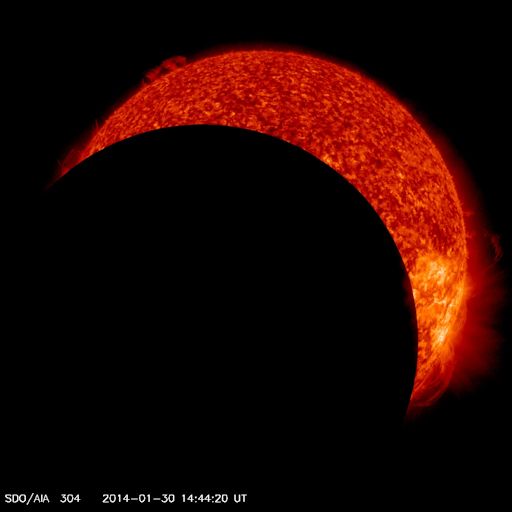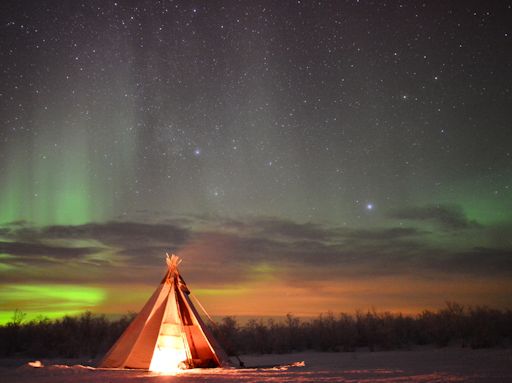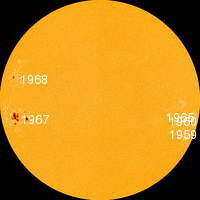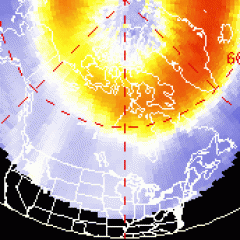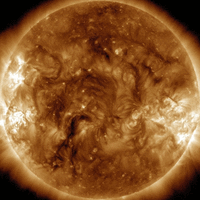
INCREASING CHANCE OF FLARES: Sunspot AR1967 has developed a 'beta-gamma-delta' magnetic field that harbors energy for strong eruptions. NOAA forecasters estimate a 60% chance of M-flares and a 10% chance of X-flares on Jan. 30th. Solar flare alerts: text, voice
LUNAR TRANSIT OF THE SUN: Today, Jan. 30th, the Moon will eclipse the sun for almost 2.5 hours. You have to be in space to see it. This extreme UV image from NASA's Solar Dynamics Observatory (SDO) shows the "lunar transit" underway now:
Before the eclipse is over at 1556 UTC (10:56 EST), as much as 90% of the sun will be covered. SDO is solar powered, so mission controllers have charged the spacecraft's batteries to endure the blackout. Stay tuned for more images!
Realtime Space Weather Photo Gallery
NON-STOP NORTHERN LIGHTS: In Sweden's Abisko National Park, Chad Blakley has been an aurora tour guide for many years. "I believe January 2014 will be remembered as the best aurora watching month of my life!" he says. "Last night, for the 25th time this year, we enjoyed an amazing display of northern lights." He stepped outside his teepee for this comemorative shot:
"The contrast of green lights in the sky and the red glow of the teepee was fantastic," he says. "Our eight guests really enjoyed photographing the display."
"With a little luck," Blakley adds, "tonight will be number 26 for the year." He might get his wish. NOAA forecasters estimate a 40% chance of polar geomagnetic storms on Jan 30th in response to a minor solar wind stream buffeting Earth's magnetic field. Aurora alerts: text, voice

Solar wind
speed: 370.9 km/sec
density: 1.7 protons/cm3
explanation | more data
Updated: Today at 1607 UT
X-ray Solar Flares
6-hr max: M3 1600 UT Jan30
24-hr: M3 1600 UT Jan30
explanation | more data
Updated: Today at: 1600 UT
![]()
Daily Sun: 30 Jan 14
Sunspot AR1967 has a 'beta-gamma-delta' magnetic field that harbors energy for X-class solar flares. Credit: SDO/HMI
![]()
Sunspot number: 96
What is the sunspot number?
Updated 30 Jan 2014
Spotless Days
Current Stretch: 0 days
2014 total: 0 days (0%)
2013 total: 0 days (0%)
2012 total: 0 days (0%)
2011 total: 2 days (<1%)
2010 total: 51 days (14%)
2009 total: 260 days (71%)
Update 30 Jan 2014
The Radio Sun
10.7 cm flux: 157 sfu
explanation | more data
Updated 30 Jan 2014
![]()
Current Auroral Oval:
Switch to: Europe, USA, New Zealand, Antarctica
Credit: NOAA/POES
![]()
Planetary K-index
Now: Kp= 0 quiet
24-hr max: Kp= 3 quiet
explanation | more data
Interplanetary Mag. Field
Btotal: 4.7 nT
Bz: 0.9 nT south
explanation | more data
Updated: Today at 1607 UT
![]()
Coronal Holes: 30 Jan 14
There are no large coronal holes on the Earthside of the sun. Credit: SDO/AIA.

